We spent last weekend at Château de la Bonnelière in Chinon. Surrounded by the beautiful Loire Valley countryside and under a blue sky, we met up with some of the Gourmet Odyssey Wine Experience clients for the first Harvest Experience Day at the winery.
The aim of this wine course is to discover what it's like to be a winemaker in a very practical and fun way. It's a sharing of knowledge between the winemaker and the clients, who learn in-situ the different facets of the profession by rolling up their sleeves and actively participating in the work themselves!
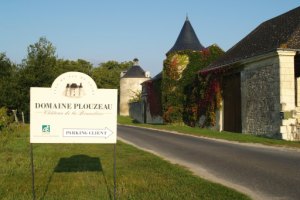
Following the introduction from Marc Plouzeau, the owner and winemaker at Château de la Bonnelière, we started the day with another introduction, that of the adopted vines! Included in each client's Wine Experience are a number of adopt-a-vines. At the beginning of each row of vines, a small personalised sign indicates the owner of the adopted vines, providing a photo opportunity to immortalise the moment in front of the vines, laden with ripe grapes!
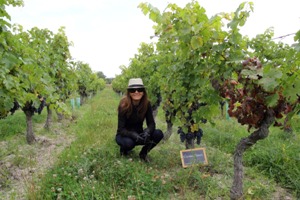
But we weren't there just to take photos! Marc had brought us a van full of crates, which we then distributed among the rows.
Marc showed us how to harvest; which grapes to cut and which to leave behind. At Château de la Bonnelière, the sorting of the grapes is done in the vineyard at the time of harvesting, and not on the sorting table, as is the custom in some wineries. It's therefore very important to only harvest the ripe grapes to ensure the quality of the wine to follow!
Secateurs and baskets in hand, we spread out among the vines in teams of two to start the harvest!
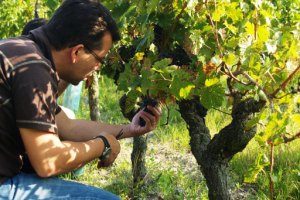
The vines at Château de la Bonnelière are bursting with grapes this year and the fruit is looking very healthy despite the wet end to the summer that the region suffered. The smile on Marc's face showed that he was happy with the condition of the grapes. It's the end of another cycle in the vineyard, but many hours, much energy and devotion have been spent in the vineyard since the last harvest to get to this point. The vine is a creeper plant, and so can grow all by itself, but to ensure that the grapes contain enough sugar to make a quality wine, it demands lots of work, especially when they are cultivated organically.
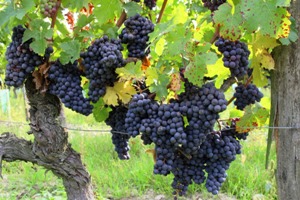
The baskets filled up quickly! Once full, we transferred the grapes into the crates before moving onto the next vines in the row.
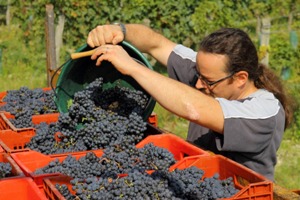
At the end of the morning, all of the crates had been filled! A tractor was waiting for us at the edge of the vineyard, and we loaded our precious harvest onto the trailer. We were surprised to learn from Marc that we our efforts represented roughly 1000 bottles! Not bad at all, especially as it was the first harvest for each of the clients!
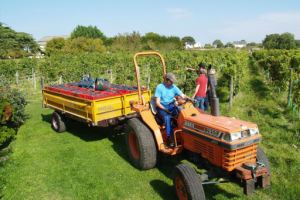
Following our grapes, we arrived at the chai to put our harvest into the fermentation tanks ourselves!
Again in teams of two we emptied the crates into the de-stemming machine, which separates the grapes from the stalks.
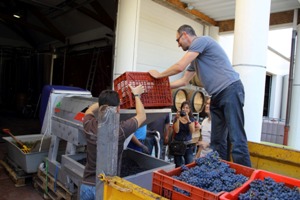
The grapes fall into a trolley underneath the machine and the stems fall the other side into a large bucket. The stems will be used as compost and spread among the vines to return some of the nutrients to the soil.
With the help of a forklift truck, the whole grape berries are then put into the top of the vats, where the fermentation will start to turn the sugar into alcohol.
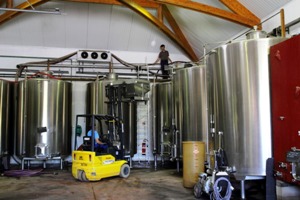
All of this work had made us thirsty, so back to the winery to taste some of the estate's wines around a few old wooden wine barrels. Accompanied by some locally-made rillettes, we tasted the Touraine Sauvignon 2010 white wine, followed by a Chinon rosé 2010.
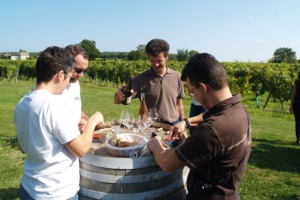
We then sat down in the shade to savour the delicious meal, prepared by Madame Plouzeau, Marc's mother. The tomato salad will be remembered for a very long time to come ! The tomatoes were picked just a few hundred metres away, and were truly bursting with flavor! She had also prepared a Blanquette de Veau, a selection of local Loire cheeses and an apple and rhubarb crumble. And of course we had some wine to accompany these delicacies; a Chinon "Rive Gauche" 2009, a Chinon "Château de la Bonnelière" 2009, and the 2009 and 2008 vintages of the Chinon "Chapelle".
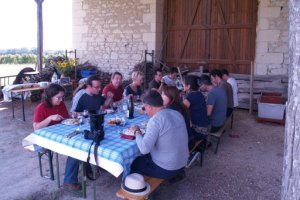
After the meal, there was still some work to be done, so we headed back to the chai. In the fermentation tanks, the grape skins rise to the top to form a cap above the liquid. It's the skin however that gives the colour and much of the wine's structure through the tanins that it contains. It's therefore vital to mix the liquid and the skins. There are various ways to do this. You can push the skin down into the liquid using the "pigeage" technique, or you can do the opposite by taking the liquid from the bottom of the vat and putting it back in the top so that the juice extracts the colour and tannins from the skin as it passes through the cap. This is method is called "remontage".
During the first stages of fermentation, Marc prefers remontage. To do so, we put a big bucket in front of the vat, and opened a tap to let the juice flow into it. We then put in place the tubes and pump to carry the liquid into the top of the vat.
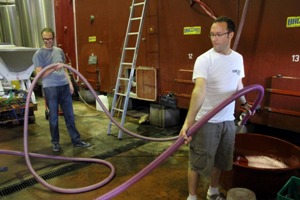
We couldn't leave without tasting the fruit of our labour, so we ended the day by tasting a cabernet franc that had been harvested a few days before and so the fermentation had already started. This lightly fermented grape juice is called "Bernache" in the region. We then compared it to a cabernet franc rosé where the fermentation was already more advanced.
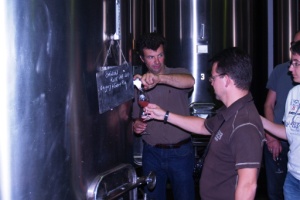
Sincere thanks to all those who came and particularly to Marc for having showed us behind the scenes during the busy harvest period. We can't wait until the next Wine Experience Day!
Comments
-
Thank you for the write up, which perfectly captures what we got up to during this thoroughly enjoyable day.
And well done for the quality of the photos!
All the best!





Envoyé le Jeudi 29 September 2011 by Renaud